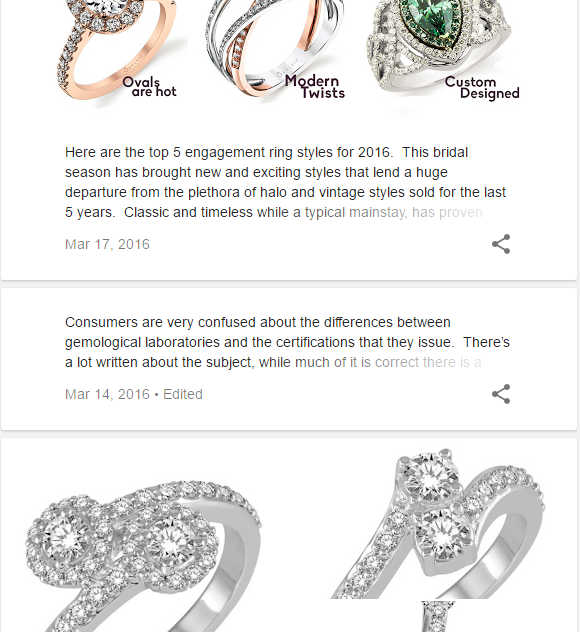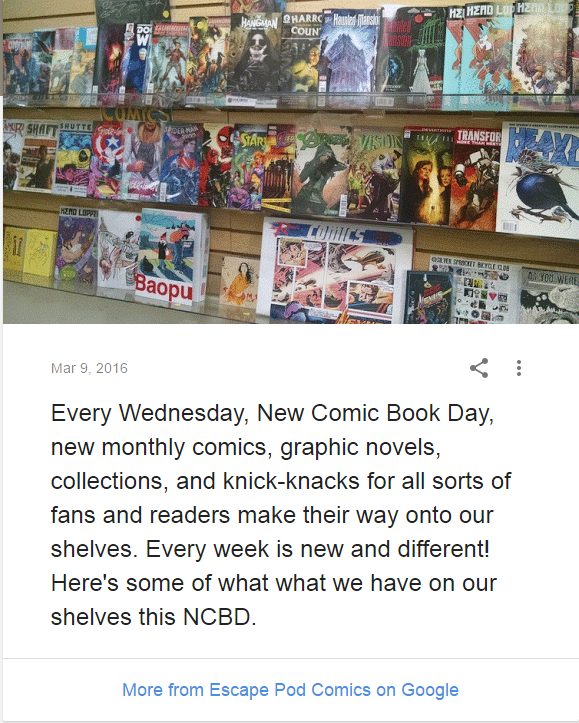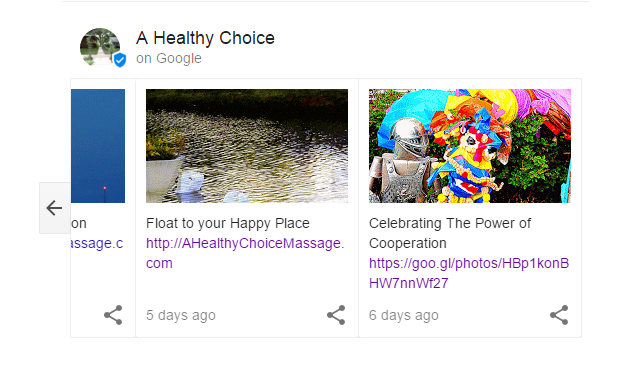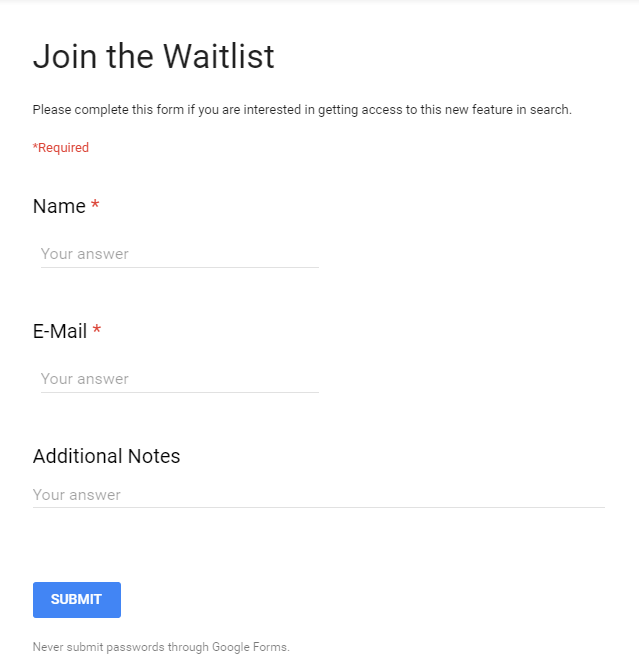Google has recently debuted a new feature giving individuals and organisations a new platform for communicating with the wider public.
Dubbed ‘Google Posts’ by most commentators – although Google has indicated that the feature does not have an official name yet – the new platform appears as a carousel of ‘card’ style updates within a search engine results page.
The feature was originally introduced as part of the U.S. Presidential Elections, as a way for presidential candidates to deliver a personal message to the public via Google. Later on, some sharp-eyed searchers noticed that Posts had been rolled out to a very limited number of local businesses in the US, and was being given a prominent billing on search results pages.
Google has been fairly quiet about the new feature’s existence so far. Search Engine Land managed to confirm with the company that this was an official test, which has been rolled out to a “few dozen” local businesses.
Of these, only three seem to be widely known about: a day spa and massage therapist, a comic book store, and a jeweller’s specialising in engagement and wedding rings. So how are these lucky few making use of Google’s newest innovation, and what can we take away for when the feature is rolled out more widely in future?
Andrews Jewelers
Andrews Jewelers was the first business to be spotted using the new feature, by local search expert Mike Blumenthal as he searched for engagement rings in Buffalo, New York.
Searchers who enter the right keywords on Google.com are presented with a miniature carousel of the most recent few posts by the business in the search results page. Each has a time stamp, and a share button which allows the posts to be republished on social media platforms like Twitter, Facebook and (in weirdly meta fashion) Google+.
Although the posts are showcased prominently in search results, businesses using Google Posts don’t seem to be artificially boosted to the top of the results page. Rather, the Posts carousel will appear directly below the business’s highest entry on the search results page, whether it be the top search result or the fourth.
Clicking on the company’s logo takes you to a feed of published posts by that company which is presented on, in Blumenthal’s words, “a slimmed-down Plus like page”. The resemblance to Google+ (and the fact that well, it is a Google creation) has caused many to speculate that the new feature could eventually be phased in as a replacement for Google+, which has noticeably been stripped out of branded searches as of late.
As a retail business, Andrews Jewelers has made use of the strong visual element of Google Posts to show off its products, with eye-catching images of their diamond rings and custom designs.
Andrews Jewelers’ updates on Posts are slightly more evergreen compared with something like its Twitter feed, promoting longer-lasting content like a diamond-buying guide, a post on the importance of prong maintenance, and current trends and styles in the jewellery world.
The business is good at linking up its various different channels, drawing attention to five-star Google reviews and encouraging readers to visit its Google+ Page.
Most interestingly, company founder Andy Moquin published a longer piece to his business’s Posts page, addressing an “ongoing debate in the jewelry industry” about gemological laboratories and diamond grading.
I’m on the fence about whether Google Posts makes the best platform for this kind of piece. The no-frills platform interface makes text posts very readable, but without an image, a text post is only given a few lines of preview in the main feed, and is very easily overlooked between the more attention-grabbing visual posts.
 I almost missed the text post here when scrolling through the feed.
I almost missed the text post here when scrolling through the feed.
Then again, when you’re one of the first businesses ever to make use of a new Google platform, anything is a good idea from a visibility standpoint. It’s cool to see businesses experimenting with different types of post on the new platform, and hopefully there’ll be plenty of room to find out what works when the feature is rolled out more widely.
Escape Pod Comics
Another local New York business, Escape Pod Comics in Huntingdon, NY, has also been spotted using Google Posts.
Escape Pod has a good mix of posts going on in its feed, using images, video, GIFs and text posts to promote the business, spotlight individual artists and highlight upcoming events. As a comic book retailer, it uses visual posts to great advantage, using GIFs to showcase a creator’s distinctive style ahead of a signing, or to show off products within the store every Wednesday (the day new comic books are released).
The page features some cross-promotion of Escape Pod’s blog, as well as a post which makes use of a screenshot from the store’s Instagram. With posts dating back to 29th February, Escape Pod Comics is also our earliest adopter of the three Google Posts businesses, as the other two feeds both date back to 1st March.
I found it entertaining that, when searching for Escape Pod Comics on Google.com (Google Posts currently only appear in search results for Google.com and not any of the localised Googles), Google has already begun to make associations between searches for the different businesses who are using Google Posts.
A Healthy Choice Spa
Our third Google Posts business is based in Lincoln, Nebraska, which promptly did away with my theory about whether the businesses that Google has chosen to debut Posts had any geographical link.
A Healthy Choice is our most frequent updater on Posts, often publishing two or three posts per day. The updates tend to be short and simple, containing just a single line of text, an image or GIF, and a link.
At this stage, it’s impossible to say whether updating more frequently on Google Posts could be an advantage, a disadvantage, or not really make a difference. In a situation where most or all businesses on Google have their own Posts feed, it’s conceivable that Google could boost the more active publishers higher up the search results, but this could also turn out not to be a factor at all.
Currently, the most that it affects is the number of recent posts which show in the ‘carousel’ on the search results page, which seem to have a cut-off period of about one week; the more posts which have been published in the past week, the more will be displayed in the carousel.
As well as updates promoting its business and the health benefits of massages, A Healthy Choice uses its feed to support and promote local events, history and causes. This isn’t unusual for social media, but when publishing to a platform which feeds directly into search results pages, I wonder if it’s such a good idea.
On the one hand, it looks good for a business to be seen promoting its local area, and building trust and respect with the nearby community is always important for local businesses.
On the other hand, with Posts from businesses appearing directly within search results, businesses might have to put on a search engine ‘hat’ and consider how to deliver the most useful information to searchers who are looking up their business on Google.
I can see it going either way, but as with most things, it will be up to businesses to refine what works when Google Posts is rolled out on a larger scale.
 What’s next for Posts?
What’s next for Posts?
It’s difficult to speculate too much about what Google plans for Posts, given that Google itself has kept so quiet about the whole project. None of the businesses taking part in the initial, experimental testing stages seems to have made an announcement about being approached or selected, leaving searchers to stumble across these early users by accident.
The homepage for Posts on Google definitely implies a wider implementation of the platform, calling it an “experimental new podium” which will allow people to “hear directly from the people and organisations [they] care about on Google.”
“Verified individuals and organisations can now communicate with text, images and videos directly on Google,” it proclaims. Anyone who is a “public figure or organisation” who would like to publish on Google can join the waiting list, though noticeably, the form doesn’t require anyone to specify why they are significant or even what organisation they represent in order to sign up.
Based on what we’ve seen of Posts so far, Google’s new feature seems like a halfway house between a new social media outlet and a publishing platform. Certainly, the early adopters seem to be using it that way.
But I think there’s potential here for Posts to become something completely new altogether. As I mentioned before, the fact that Posts are published directly into search results means that publishers will have to bear searchers in mind as their audience with their presentation and the information they provide.
The key thing setting Google Posts apart from social media (and blogging platforms) is the lack of interactivity. You can share posts, but not otherwise comment on or interact with them. That could always change in future, but I think it’s a statement of intent as to where Google is going with this feature.
Speculation about replacing Plus aside, I don’t think Google is setting out to create a self-contained social network with its own ecosystem, but something that extends more seamlessly from existing Google search. It’s not just another social network or another publishing platform – both of which Google already owns.
But combining elements of both with the huge ‘audience’ that Google (as the world’s most popular search engine) commands makes using Posts a very attractive prospect indeed, at least from a business perspective.
I think the next big consideration will be whether users find it beneficial, or whether it will be seen as just another level of clutter trying to draw their attention away from the information they’re searching for.
The article How are businesses using Google Posts? was first seen from https://searchenginewatch.com






No comments:
Post a Comment